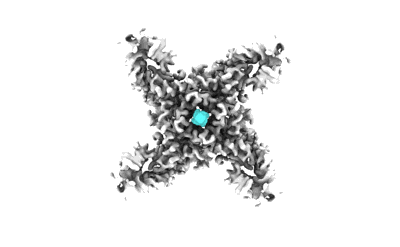EMD-36039
ion channel
EMD-36039
Single-particle2.6 Å
 Deposition: 27/04/2023
Deposition: 27/04/2023Map released: 15/05/2024
Last modified: 15/01/2025
Sample Organism:
Homo sapiens,
Aequorea victoria
Sample: ion channel complex
Fitted models: 8j7f (Avg. Q-score: 0.555)
Deposition Authors: Chen HW, Jiang D
Sample: ion channel complex
Fitted models: 8j7f (Avg. Q-score: 0.555)
Deposition Authors: Chen HW, Jiang D

Structural mechanism of voltage-gated sodium channel slow inactivation.
Chen H,
Xia Z,
Dong J,
Huang B  ,
Zhang J,
Zhou F,
Yan R,
Shi Y,
Gong J
,
Zhang J,
Zhou F,
Yan R,
Shi Y,
Gong J  ,
Jiang J
,
Jiang J  ,
Huang Z
,
Huang Z  ,
Jiang D
,
Jiang D 
(2024) Nat Commun , 15 , 3691 - 3691
 ,
Zhang J,
Zhou F,
Yan R,
Shi Y,
Gong J
,
Zhang J,
Zhou F,
Yan R,
Shi Y,
Gong J  ,
Jiang J
,
Jiang J  ,
Huang Z
,
Huang Z  ,
Jiang D
,
Jiang D 
(2024) Nat Commun , 15 , 3691 - 3691
Abstract:
Voltage-gated sodium (NaV) channels mediate a plethora of electrical activities. NaV channels govern cellular excitability in response to depolarizing stimuli. Inactivation is an intrinsic property of NaV channels that regulates cellular excitability by controlling the channel availability. The fast inactivation, mediated by the Ile-Phe-Met (IFM) motif and the N-terminal helix (N-helix), has been well-characterized. However, the molecular mechanism underlying NaV channel slow inactivation remains elusive. Here, we demonstrate that the removal of the N-helix of NaVEh (NaVEhΔN) results in a slow-inactivated channel, and present cryo-EM structure of NaVEhΔN in a potential slow-inactivated state. The structure features a closed activation gate and a dilated selectivity filter (SF), indicating that the upper SF and the inner gate could serve as a gate for slow inactivation. In comparison to the NaVEh structure, NaVEhΔN undergoes marked conformational shifts on the intracellular side. Together, our results provide important mechanistic insights into NaV channel slow inactivation.
Voltage-gated sodium (NaV) channels mediate a plethora of electrical activities. NaV channels govern cellular excitability in response to depolarizing stimuli. Inactivation is an intrinsic property of NaV channels that regulates cellular excitability by controlling the channel availability. The fast inactivation, mediated by the Ile-Phe-Met (IFM) motif and the N-terminal helix (N-helix), has been well-characterized. However, the molecular mechanism underlying NaV channel slow inactivation remains elusive. Here, we demonstrate that the removal of the N-helix of NaVEh (NaVEhΔN) results in a slow-inactivated channel, and present cryo-EM structure of NaVEhΔN in a potential slow-inactivated state. The structure features a closed activation gate and a dilated selectivity filter (SF), indicating that the upper SF and the inner gate could serve as a gate for slow inactivation. In comparison to the NaVEh structure, NaVEhΔN undergoes marked conformational shifts on the intracellular side. Together, our results provide important mechanistic insights into NaV channel slow inactivation.
